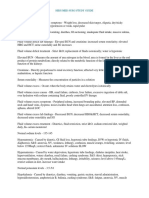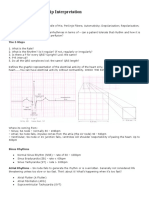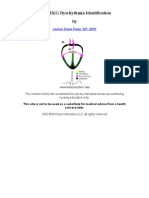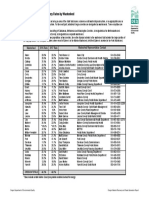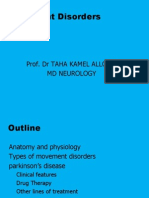DYSRHYTHMIAS
DYSRHYTHMIAS
Uploaded by
gudobenCopyright:
Available Formats
DYSRHYTHMIAS
DYSRHYTHMIAS
Uploaded by
gudobenCopyright
Available Formats
Share this document
Did you find this document useful?
Is this content inappropriate?
Copyright:
Available Formats
DYSRHYTHMIAS
DYSRHYTHMIAS
Uploaded by
gudobenCopyright:
Available Formats
DYSRHYTHMIAS
TYPE
Sinus Bradycardia
CHARACTERISTIC
Sinus rhythm with a resting heart rate of 60 beats per minutes or less Rate- 40-59 bpm P wave- sinus QRS- normal (.06-.12) Conduction- PR normal or slightly prolonged at slower rates Rhythm- regular or slightly irregular A rhythm with elevated rate of impulses originating from the sinoatrial node, defined as a rate greater that 100 beats per minute in an average adult Rate- 101-160 bpm P wave- sinus QRS- normal (.06-.12) Conduction- normal Rhythm- regular or slightly irregular A normal phenomenon of mild acceleration and slowing of the heart rate that occurs with breathing in and out Rate- 45-100 bpm P wave- sinus QRS- normal (.06-.12) Conduction- normal Rhythm- regular or irregular
DRAWING
Sinus Dysrhythmias
MANAGEMENT
y Medical- Treat the underlying cause, atropine, isuprel, artificial pacing if patient is hemodynamically compromised, anticholinergics y Nursing- Intravenous access, supplemental oxygen, and cardiac monitoring should be initiated in the field; ensuring the stability of the patient s condition; continuous monitoring and intravenous access y Medical- identifying and correcting the underlying cause; beta blockers y Nursing- ensuring the stability of the patient s condition; continuous cardiac monitoring and intravenous access
Sinus Tachycardia
Sinus Arrythmia
y Medical- treatment is not usually required unless symptomatic bradycardia is present y Nursing- ensuring the stability of the patient s condition; continuous cardiac monitoring and intravenous access
Atrial Dysrhythmias Wandering Atrial Pacemaker May occur in normal hearts as a result of fluctuations in vagal tone. It may also be seen in patients with heart disease or COPD Rate- variable depending on the site of the pacemaker; usually 45-110 bpm y Medical- usually no treatment required y Nursing- ensure the stability of the patient s condition; continuous monitoring and intravenous access
Premature Atrial Contractions
P wave- also variable in morphology QRS- normal (.06-.12) Conduction- PR interval varies depending on the site of the pacemaker Rhythm- irregular Normally in a non-diseased heart. However, if they occur frequently they may lead to a more serious atrial dysrhythmias; they can also result from CHF, ischemia and COPD Rate- normal or accelerated P wave- usually have a different morphology than sinus P waves because they originate from an ectopic pacemaker QRS- normal (.06-.12) Conduction- normal, however, the ectopic beats may have a different PR interval (0.170.20) Rhythm- PAC s occur early in the cycle and they usually do not have a complete compensatory pause This may occur in individuals with healthy hearts. It may also occur with increased vagal tone, myocarditis, MI, and digitalis toxicity Rate- normal P wave- those that are present are normal QRS- normal (.06-.12) Conduction- normal Rhythm-the basic rhythm is regular. The length of the pause is not a multiple of the sinus interval A type of heart block which involves an impairment of conduction at the sinoatrial node Rate- normal or bradycardia P wave- those that are present are normal QRS- normal (.06-.12) Conduction- normal
y Medical- treatment includes identification of the underlying cause and correction y Nursing- ensure the stability of the patient s condition; continuous cardiac monitoring and intravenous access
Sinus Arrest
y Medical- if the cause is due to increased vagal tone and the patient is symptomatic, atropine may be indicated y Nursing- ensure the stability of the patient s condition; monitoring and intravenous access; decrease or stop stimuli; stress reduction; decrease or stop alcohol intake; oxygen 2-4 liters per minute as prescribed; heat electrolyte imbalance; monitor cardiac rhythm and vital signs y Medical- identification and correction of the underlying cause y Nursing- ensure the stability of the patient s condition; continuous cardiac monitoring and intravenous access
Sinoatrial Block
Multifocal Atrial Tachycardia
Rhythm- basic rhythm is regular A cardiac arrhythmia, specifically a type of supraventricular tachycardia Rate- 100-250 bpm P wave- two or more ectopic P waves with different morphologies QRS- normal (.06-.12) Conduction- PR intervals vary Rhythm- irregular A rapid rhythm of the heart in which the origin of the electrical signal is either the atria or the AV node Rate- atrial 160-250 bpm: may conduct to ventricles 1:1, or 2:1, 3:1, 4:1 into the presence of a block P wave- morphology usually varies from sinus QRS- normal (.06-.12)(unless associated with aberrant ventricular conduction) Conduction- PR interval depends on the status of AV conduction tissue and atrial rate: maybe normal, abnormal, or not measurable An abnormal heart rhythm that occurs in the atria of the heart Rate- a atrial 250-400 bpm; ventricular conduction depends on the capability of the AV junction (usually rate of 150-175 bpm) P wave- not present; usually a saw tooth pattern is present (unless associated with aberrant ventricular conduction) QRS- normal (.06-.12) Conduction- 2:1 atrial to ventricular most common Rhythm- usually regular, but can be irregular if the AV block varies A cardiac arrhythmia that involves the two upper chambers of the heart. It can often be
y Medical- Treatment depends upon the underlying cause; its rate can be reduced by administering verapamil y Nursing- ensuring the stability of the patient s condition; continuous cardiac monitoring and intravenous access; its rate can be reduced by administering verapamil
Paroxysmal Atrial Tachycardia
y Medical- adenosine diltiazem, verapamil or metoprolol sotaloi or amiodarone; cardioversion may be used; AV nodal blocking agents like beta-blockers and verapamil; radio frequency ablation y Nursing- valsalva maneuver; instruct patients the following: holding ones breath for a few seconds, coughing, plunging the face into cold water- via the diving reflex , drinking a glass of ice cold water, and standing on one s head; carotid sinus massage
Atrial Flutter
y Medical- cardioversion, vagal maneuvers and verapamil are used when prompt rate reduction is needed; otherwise, digoxin and other ant arrhythmic drugs can be used; anticoagulation of anti-platelet agent; amiodarone, calcium channel blockers, beta blockers y Nursing- vagal maneuvers, ensuring the stability of the patients condition; assess decrease in heart rate; vagal stimulation; carotid sinus massage; oxygen; know underlying condition; electrical synchronized cardioversion y Medical- digoxin, diltiazem, or other antidysrhythmic medications to control the AV
Atrial Fibrillation
identified by taking a pulse and observing that the heartbeats don t occur at regular intervals, but a conclusive indication of AF is the absence of P waves on an electrocardiogram Rate- atria rate usually between 300-600 bpm P wave- not present; wavy baseline is seen instead QRS- normal (.06-.12) Conduction- variable AV conduction; if untreated the ventricular response is usually rapid Rhythm- irregularly irregular Junction Dysrhythmias Premature Junctional Contractions PJCs may occur in both healthy and diseased hearts. If they are occasional, they are insignificant. If they are frequent, junctional tachycardia may result Rate- normal or accelerated. Present; wavy baseline is seen instead P wave- as with junctional rhythm QRS- normal (.06-.12) Conduction- PR interval <0.12 seconds if P waves are present Rhythm- PJC s occur early in the cycle of the baseline rhythm. A full compensatory pulse may occur The clinical significance of the rhythm depends upon the basic rhythm disturbance. If the ventricular rate is rapid, cardiac output may decrease Rate- faster than 10 bpm P wave- as with junctional rhythm QRS- normal (.06-.12) or widened with aberrant ventricular condition Conduction- PR interval usually <0.12
conduction rate and assist with conversion back to normal sinus rhythm; cardioversion may also be necessary to terminate this rhythm; anticoagulation; electrophysiological studies y Nursing- prevent temporary circulatory instability and to prevent stroke; asses for bleeding; administer anticoagulants as ordered; oxygen; give amiodarone as prescribed
y Medical- not usually required y Nursing- assess for frequency
Junctional Tachycardia
y Medical- finding and correcting the underlying cause; vagal maneuvers; verapamil and cardioversion y Nursing- vagal maneuvers; ensure the stability of the patient s condition
Junctional Escape Beats and Rhythm
seconds if present Rhythm- usually regular The most common cause of this rhythm in healthy individuals is sinus bradycardia. It may also be seen in the presence of a high degree or complete AV block. If the ventricular rate is slow, hemodynamic compromise may occur Rate- 40-60 bpm P wave- inverted in leads where they are normally upright; this happens when the atrial depolarization wave moves towards a negative lead. P waves may occur before, during and after the QRS, depending in where the pacemaker is located in the AV junction QRS- normal (.06-.12) Conduction- PR interval <0.12 seconds if present Rhythm- irregular as a result of the escape beats Blocks
y Medical- atropine or a pacemaker may be used to increase the ventricular rate y Nursing- ensure the stability of the patient s condition
First Degree AV Block or PR prolongation
A disease of the electrical conduction system of the heart in which the PR interval is lengthened beyond 0.20 seconds Rate- variable P wave- normal QRS- normal (.06-.12) Conduction- impulse originates in the SA node but has prolonged conduction in the AV junction; PR interval is >0.20 seconds Rhythm- regular Disease of the electrical conduction system of the heart. It refers to a conduction block between the atria and ventricles Rate- variable P wave- normal morphology with constant PP
y Medical- treating the underlying cause and observing for progression to a more advanced AV block. y Nursing- follow-up check-ups and monitoring of ECG
Second Degree AV Block (Mobitz type I, Wenkebach)
y Medical- no specific treatment is needed y Nursing- observe for untoward signs and symptoms
interval QRS- normal (.06-.12) Conduction- The PR interval is progressively longer until one P wave is blocked; the cycle begins again following the blocked P wave Rhythm- irregular Second Degree AV Block (Mobitz type II) Mobitz II heart block is characterized on a surface by intermittently nonconducted P waves not preceded by PR prolongation and not followed by PR shortening. The medical significance of theis type of AV block is that it may progress rapidly to complete heart block, in which no escape rhythm may emerge Rate- variable P wave- normal with constant PP intervals QRS- usually widened because this is usually associated with a bundle branch block Conduction- PR interval maybe normal or prolonged, but it is constant until one P wave is not conducted to the ventricles Rhythm- usually regular when AV conduction ratios are constant Third Degree AV Block or Complete AV Block A defect of the electrical system of the heart, in which the generated in the atria (typically the SA node on top of the right atrium) does not propagate to the ventricles Rate- atrial rate is usually normal; ventricle rate is usually less than 70 bpm. The atrial rate is always faster than the ventricular rate P wave- normal with constant PP intervals, but not married to the QRS complexes QRS- may be normal or widened depending on where the escape pacemaker is located in the conduction system Conduction- atrial and ventricular activities y Medical- extreme pacing and atropine for acute, symptomatic episodes and permanent pacing for chronic complete heart block y Nursing- administration of atropine y Medical- treatment is usually artificial pacing y Nursing- ensuring the stability of the patient s condition
are unrelated due to the complete blocking of the atrial impulses Rhythm- irregular Bundle Branch A defect of the heart s electrical conduction Block system Rate- variable P wave- normal if the underlying rhythm is sinus QRS- wide; >0.12 seconds Conduction- this block occurs in the right or left bundle branches or in both. The ventricle that is supplied by the blocked bundle is depolarized abnormally Rhythm- regular or irregular depending on the underlying rhythm Ventricular Dysrhythmias Premature Ventricular Contraction or Ventricular Premature Beat or Extrasystole Is a form of irregular heartbeat in which the ventricle contracts prematurely. This may be perceived as a skipped beat or as palpitations. The depolarization of cardiac myocytes begins in the ventricle instead of the usual place, the sinoatrial node Rate- variable P wave- usually obscured by the QRS,PST or T wave of the PVC QRS- wide >0.12 seconds; morphology is bizarre with the ST segment and the T wave opposite in polarity. Maybe multifocal and exhibit different morphologies Conduction- the impulse originates below the branching portion of the Bundle of His; full compensatory pause is characteristic Rhythm- irregular. PVC s may occur in singles, couplets or triplets; or in bigeminy, trigeminy, or quadrigeminy A tachycardia, or fast heart rhythm that originates in one of the ventricles of the
y Medical- treatment is artificial pacing for a bifasicular block that is associated with an acute MI y Nursing-
y Medical- no specific treatment; electrolyte; oxygen; eliminate stimulant; administer lidocaine, pronestyl or quinidine, betablockers, and benzodiazepines y Nursing- continuous rehydration and by restoring the balance of magnesium, calcium, and potassium within the body; instruct patient that the most effective treatment is the elimination of triggers (particularly the cessation of the abuse of substances such as caffeine, cocaine, and amphetamines)
Ventricular Tachycardia
y Medical- electrical countershock is the intervention of choice if the patient is
heart. This is a potentially life-threatening arrhythmia because it may lead to ventricular fibrillation and sudden death. Although less common, some forms of this arrhythmia appear benign, especially in young individuals Rate- usually between 100-220 bpm, but can be as rapid as 250 bpm P wave- obscured if present and are unrelated to the QRS complexes QRS- wide and bizarre morphology Conduction- the impulse originates below the branching portion of the Bundle of His; full compensatory pause is characteristic Rhythm- three or more ventricular beats in a row; maybe regular or irregular The French term that literally means twisting of the points . It refers to a specific variety of ventricular tachycardia that exhibits distinct characteristics on the electrocardiogram Rate- usually between 150 to 220 bpm P wave- obscured if present QRS- wide and bizarre morphology Conduction- the impulse originates below the branching portion of the Bundle of His; full compensatory pause is characteristic Rhythm- irregular A condition in which there is uncoordinated contraction of the cardiac muscle of the ventricles in the heart, making them tremble rather than contract properly. Ventricular fibrillation is a medical emergency. If the arrhythmia continues for more than a few seconds, blood circulation will cease, and death may occur in a matter of minutes Rate- unattainable P wave- may be present, but obscured by
symptomatic and rapidly deteriorating; some pharmacological interventions include amiodarone and lidocaine y Nursing- cardiac monitoring; oxygen; electrolyte
Torsade de Pointes
y Medical- synchronized cardioversion is indicated when the patient is unstable; IV magnesium; IV potassium to correct an electrolyte imbalance; overdrive pacing y Nursing- administer magnesium sulfate and antiarrhythmic drugs as prescribed
Ventricular Fibrillation
y Medical- immediate defibrillation and ACLS protocols; identification and treatment of the underlying cause is also needed y Nursing- administer antiarrhythmic agents like amiodarone or lidocaine as prescribed
ventricular waves QRS- not apparent Conduction- chaotic Rhythm- chaotic electrical activity
You might also like
- Dysrhythmia Interpretation Modules 1-6 June 2012Document126 pagesDysrhythmia Interpretation Modules 1-6 June 2012Jess Varose100% (3)
- ATI CompDocument9 pagesATI CompTee Wood100% (1)
- VATI Med Surg RemediationDocument2 pagesVATI Med Surg RemediationestberryNo ratings yet
- Basic EKG Interpretation ExamDocument13 pagesBasic EKG Interpretation Examtwdroppoint100% (1)
- DYSRHYTHMIAS (A.k.a. Arrhythmias) Disorders in TheDocument3 pagesDYSRHYTHMIAS (A.k.a. Arrhythmias) Disorders in TheDarell M. Book100% (1)
- Comprehensive Nclex Notes Easy To Read PDFDocument97 pagesComprehensive Nclex Notes Easy To Read PDFKenia GeorgesNo ratings yet
- ATI IV TherapyDocument8 pagesATI IV Therapylisa100% (1)
- Chart of Neuro DisordersDocument1 pageChart of Neuro DisordersNursingSchoolNotes100% (2)
- Exam 3 Review Med SurgDocument18 pagesExam 3 Review Med SurgCarol ReidNo ratings yet
- ABG Tic Tac Toe Part 1Document2 pagesABG Tic Tac Toe Part 1Shala Miller100% (1)
- Ecg RhythmsDocument9 pagesEcg RhythmsNoreena Princess100% (1)
- LS Identifying ArrhythmiasDocument5 pagesLS Identifying ArrhythmiasClaudia Park100% (1)
- Abnormal Slow Heart Beats, A Simple Guide To The Condition, Diagnosis, Treatment And Related ConditionsFrom EverandAbnormal Slow Heart Beats, A Simple Guide To The Condition, Diagnosis, Treatment And Related ConditionsNo ratings yet
- Nursing Patho CardsDocument195 pagesNursing Patho Cardsgiogmail100% (1)
- Hesi Med Surg Study GuideDocument1 pageHesi Med Surg Study GuideGeorgeNo ratings yet
- Nervous System AlterationsDocument45 pagesNervous System AlterationsMajesty ParkerNo ratings yet
- ABGs Respiratory/MetabolicDocument3 pagesABGs Respiratory/MetabolicJoe B100% (1)
- Hemodynamic Assessment ParametersDocument2 pagesHemodynamic Assessment ParametersalexNo ratings yet
- Cardiac Meds To MemorizeDocument4 pagesCardiac Meds To MemorizekellyaeNo ratings yet
- Heart Failure RevisionDocument4 pagesHeart Failure RevisionBlanaid MargaretNo ratings yet
- Cardiac II Study GuideDocument6 pagesCardiac II Study GuiderunnermnNo ratings yet
- Unit 3 Study Guide Adult IIDocument7 pagesUnit 3 Study Guide Adult IINursingSchoolNotesNo ratings yet
- Hesi Med Surg Study GuideDocument1 pageHesi Med Surg Study GuideGeorge0% (1)
- ABG InterpretationDocument11 pagesABG InterpretationertrggerNo ratings yet
- Critical Care Concept MapDocument2 pagesCritical Care Concept Mapapi-599696709No ratings yet
- ACLS Algorithms (2011)Document6 pagesACLS Algorithms (2011)senbonsakuraNo ratings yet
- MedSurgATI1Document97 pagesMedSurgATI1LeelanRamphal100% (1)
- Cardiovascular Med Surg Memory Notebook of NursingDocument8 pagesCardiovascular Med Surg Memory Notebook of NursingdmsapostolNo ratings yet
- ATI Community Health Proctored Exam 2020Document7 pagesATI Community Health Proctored Exam 20204 u0% (1)
- How To Read An ECGDocument21 pagesHow To Read An ECGSlychenko100% (2)
- 5 Steps To Rhythm Strip InterpretationDocument2 pages5 Steps To Rhythm Strip Interpretationjosh082572No ratings yet
- ATI Notes PsychDocument6 pagesATI Notes PsychwaliworldNo ratings yet
- SBARQ FormDocument1 pageSBARQ FormTracy100% (5)
- Shock Study GuideDocument8 pagesShock Study GuideMadameb1No ratings yet
- My Cheat SheetDocument3 pagesMy Cheat SheetTenzin KyizomNo ratings yet
- Ards and RF FileDocument12 pagesArds and RF FileEdwin Delos Reyes Abu100% (1)
- Coumadin Dosing GuideDocument3 pagesCoumadin Dosing Guidemorale28No ratings yet
- Respiratory MedicationsDocument14 pagesRespiratory MedicationsissaiahnicolleNo ratings yet
- MS HESI Study GuideDocument6 pagesMS HESI Study Guidejustjesko0l100% (3)
- Ati RN Comprehensive Predictor Retake 2023 Latest Updated May 2023 Latest Updates Question and Answers ADocument6 pagesAti RN Comprehensive Predictor Retake 2023 Latest Updated May 2023 Latest Updates Question and Answers Aiannyaga450No ratings yet
- Cardiac Medications:: What's With The Mixing & Matching?Document97 pagesCardiac Medications:: What's With The Mixing & Matching?TinaHoNo ratings yet
- Cardiac Study Guide PDFDocument11 pagesCardiac Study Guide PDF281175100% (2)
- Mechanical Ventilation For NursingDocument55 pagesMechanical Ventilation For NursingAmira AttyaNo ratings yet
- Nclex ReviewDocument12 pagesNclex ReviewNathalee Walker50% (2)
- 37 Cardiac Problems PDFDocument9 pages37 Cardiac Problems PDFsarasmith1988No ratings yet
- Cardiac Drug FunctionDocument2 pagesCardiac Drug FunctionShanda Rieder KozickiNo ratings yet
- Basic EKG Dysrhythmia IdentificationDocument40 pagesBasic EKG Dysrhythmia IdentificationIlda Dhe Devis Spaho100% (1)
- Sinus Rhythm DisturbancesDocument3 pagesSinus Rhythm DisturbancesMarcus Philip GonzalesNo ratings yet
- Critical CareDocument25 pagesCritical Carejassen karylle IbanezNo ratings yet
- Liver Nursing NotesDocument7 pagesLiver Nursing NotesHeather ShantaeNo ratings yet
- Med Surg Respiration-Cardiac NotesDocument11 pagesMed Surg Respiration-Cardiac Notesorganictallgirl50% (2)
- HW InotropesDocument3 pagesHW InotropesNatalie YeohNo ratings yet
- Chapter 35 - Ignatavicius Medical Surgical NursingDocument6 pagesChapter 35 - Ignatavicius Medical Surgical Nursinggrkpanygiri100% (5)
- How To Read An EKG StripDocument9 pagesHow To Read An EKG StripRavi PandeNo ratings yet
- EKG Self Study GuideDocument40 pagesEKG Self Study GuideArgee AlonsabeNo ratings yet
- A Simple Guide to Hypovolemia, Diagnosis, Treatment and Related ConditionsFrom EverandA Simple Guide to Hypovolemia, Diagnosis, Treatment and Related ConditionsNo ratings yet
- A Simple Guide to Circulatory Shock, Diagnosis, Treatment and Related ConditionsFrom EverandA Simple Guide to Circulatory Shock, Diagnosis, Treatment and Related ConditionsNo ratings yet
- A Simple Guide to Abdominal Aortic Aneurysm, Diagnosis, Treatment and Related ConditionsFrom EverandA Simple Guide to Abdominal Aortic Aneurysm, Diagnosis, Treatment and Related ConditionsNo ratings yet
- SDS Westpac Ready Mix CompoundsDocument8 pagesSDS Westpac Ready Mix CompoundsSherif ShahinNo ratings yet
- PerDev Q1W6 The Power of MindDocument36 pagesPerDev Q1W6 The Power of Mindjzwf8m82gjNo ratings yet
- Razvan Florin MorosanDocument3 pagesRazvan Florin Morosandariaivanov25No ratings yet
- Soft Tissue Management in Implant DentistryDocument37 pagesSoft Tissue Management in Implant DentistryAhmad Alhakim0% (1)
- Effects Nof Students' Alcoholism On Their Academic Performance in Jose Rizal Memotial State University, Dipolog CampusDocument5 pagesEffects Nof Students' Alcoholism On Their Academic Performance in Jose Rizal Memotial State University, Dipolog CampusbengNo ratings yet
- Wasteshed RatesDocument1 pageWasteshed RatesSinclair Broadcast Group - EugeneNo ratings yet
- Classification of Traumatic InjuryDocument37 pagesClassification of Traumatic InjurybhalaashokkumarNo ratings yet
- Theoretical Framework in Nursing PracticeDocument4 pagesTheoretical Framework in Nursing Practicemaha_alkhaldiNo ratings yet
- Additional Text 14Document5 pagesAdditional Text 14ghelock valentinoNo ratings yet
- Basic Life Support: 1St AssingnmentDocument2 pagesBasic Life Support: 1St AssingnmentHessa AloliwiNo ratings yet
- Perceptions of Home Cooking'Document12 pagesPerceptions of Home Cooking'Gabriela Brito de Lima SilvaNo ratings yet
- Male CatheterizationDocument30 pagesMale CatheterizationJoeurielle CarteraNo ratings yet
- Review On Formulations of Rasakarpura (Mercurial Salt) : Ayurpharm Int J Ayur Alli Sci., Vol.2, No.3 (2013) Pages 69 - 76Document8 pagesReview On Formulations of Rasakarpura (Mercurial Salt) : Ayurpharm Int J Ayur Alli Sci., Vol.2, No.3 (2013) Pages 69 - 76Mayur MulyeNo ratings yet
- Movement Disorders: Prof. DR Taha Kamel Alloush MD NeurologyDocument68 pagesMovement Disorders: Prof. DR Taha Kamel Alloush MD NeurologyKhaled OssamaNo ratings yet
- NTSB A 14 60 ARFFWG Final Version September 2018Document129 pagesNTSB A 14 60 ARFFWG Final Version September 2018FranciscoVicenteNo ratings yet
- 18 Ophthalmology SBADocument92 pages18 Ophthalmology SBAArjun KumarNo ratings yet
- Show Public Doc-4Document12 pagesShow Public Doc-4charlie minatoNo ratings yet
- Sectional RPDDocument5 pagesSectional RPDTejas KhaireNo ratings yet
- Homoeo at A Glance PDFDocument12 pagesHomoeo at A Glance PDFNarasimharao VennelakantiNo ratings yet
- Cephalopelvic DisproportionDocument7 pagesCephalopelvic DisproportionEli Ayase100% (1)
- Emergency and Disaster Nursing Triage Exercises 2023Document37 pagesEmergency and Disaster Nursing Triage Exercises 2023Enash RidNo ratings yet
- MOA For Research - ReviewedDocument8 pagesMOA For Research - ReviewedSummerRainNo ratings yet
- 244 JMSCRDocument7 pages244 JMSCRdrzana78No ratings yet
- Professional Safety - April 2020Document60 pagesProfessional Safety - April 2020Antonio RamirezNo ratings yet
- Niosh 1405Document6 pagesNiosh 1405MICROLABORATORIO S.A de C.VNo ratings yet
- Career Paths Medical-Unit 1 Flashcards - QuizletDocument3 pagesCareer Paths Medical-Unit 1 Flashcards - QuizletHoàn ĐinhNo ratings yet
- Chapter 4Document6 pagesChapter 4Hacker 2k19No ratings yet
- Anticoagulation in Atrial Fibrillation 2020Document9 pagesAnticoagulation in Atrial Fibrillation 2020blancahechicera89No ratings yet
- Mental Health Interventions For Adolescents in SubDocument13 pagesMental Health Interventions For Adolescents in SubEffortNo ratings yet
- RUHS service and promotion rulesDocument47 pagesRUHS service and promotion rulesbhansalisumitNo ratings yet























